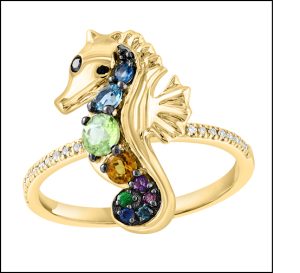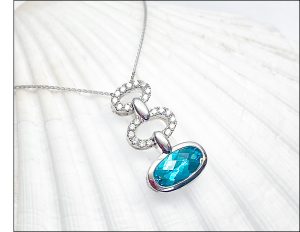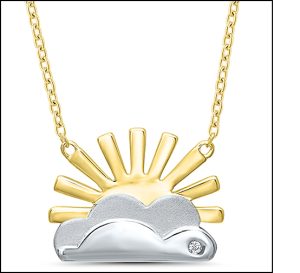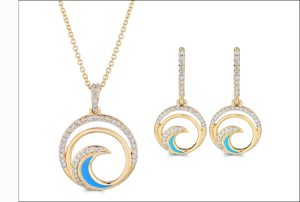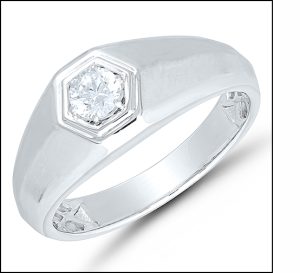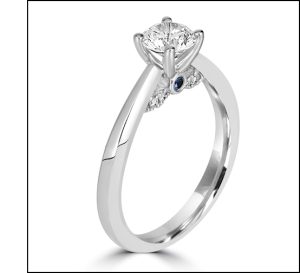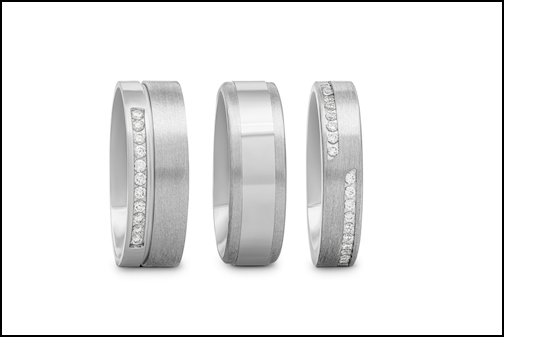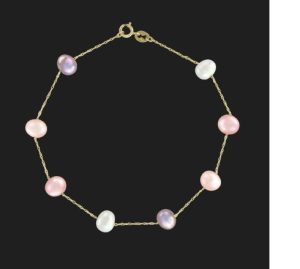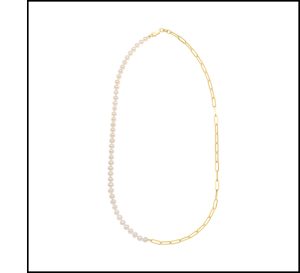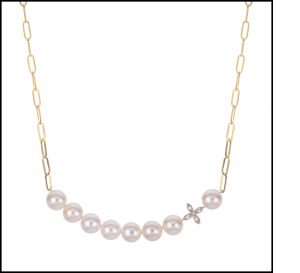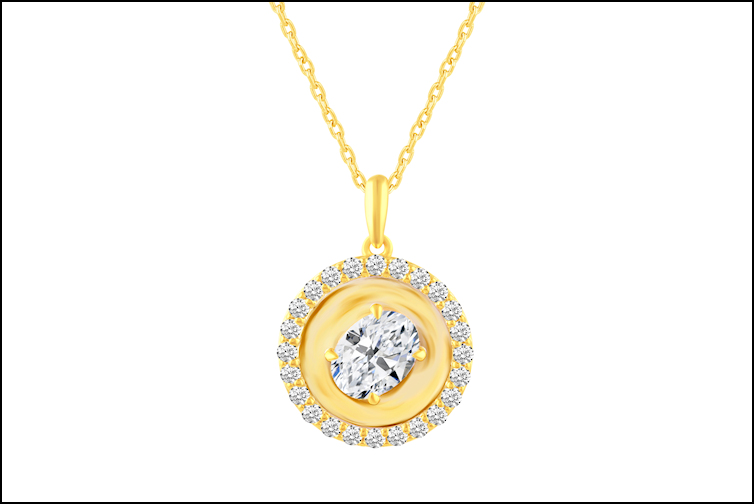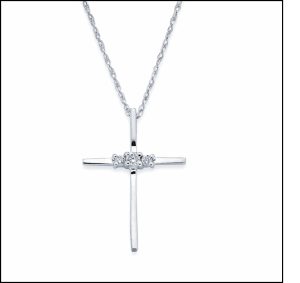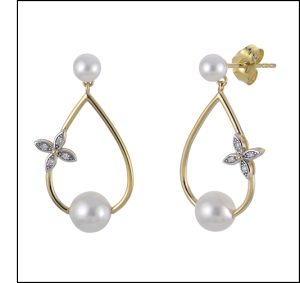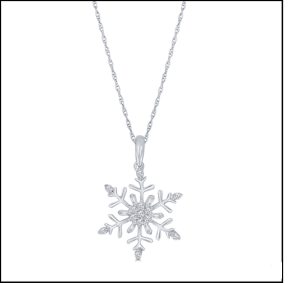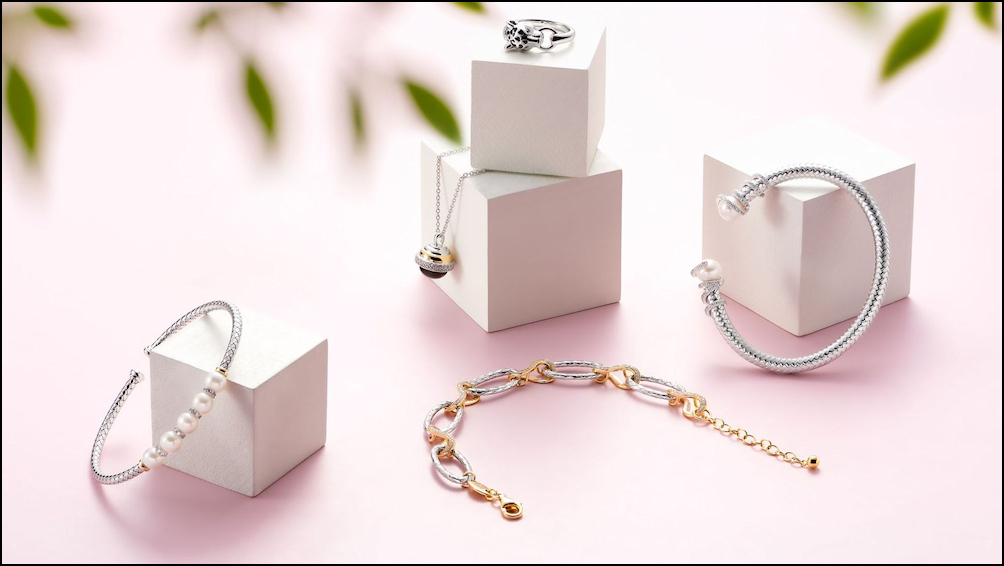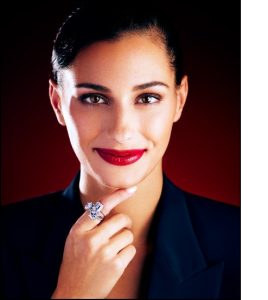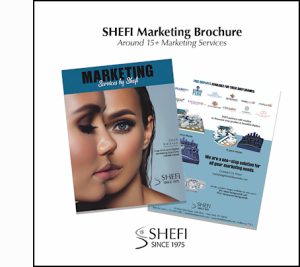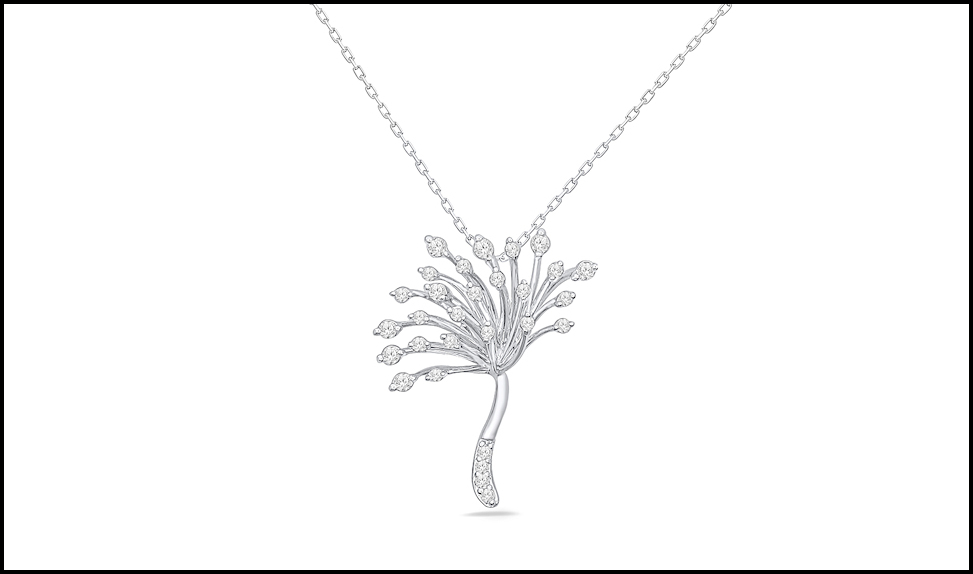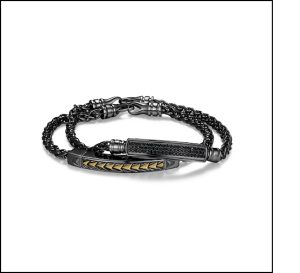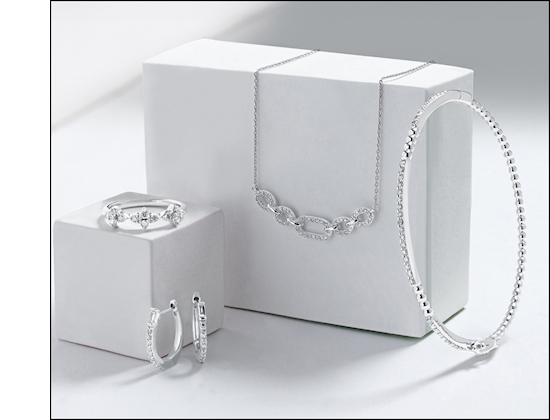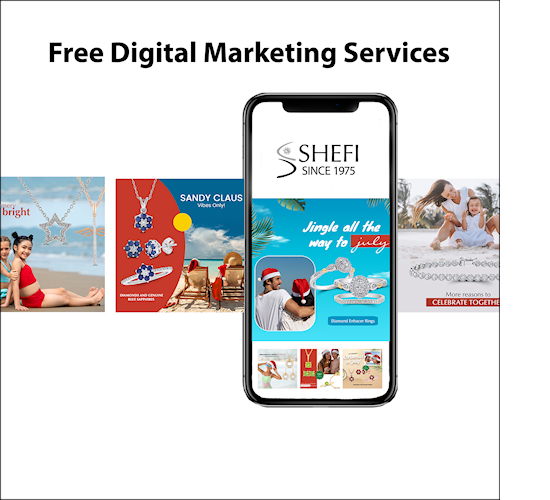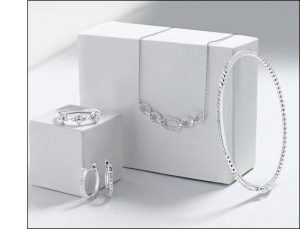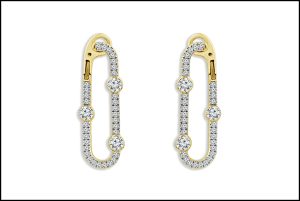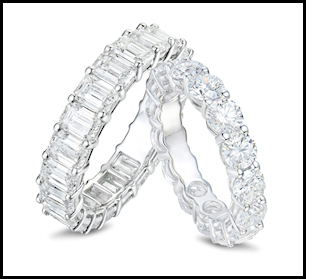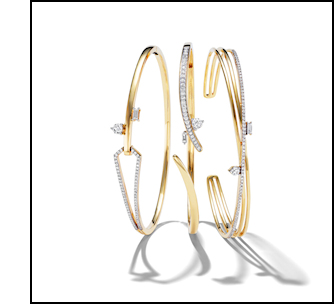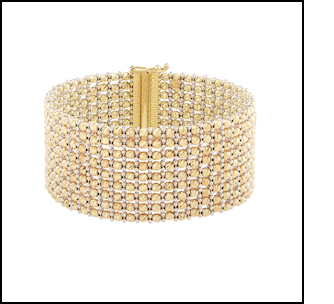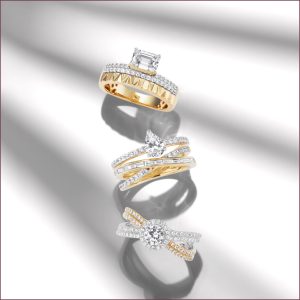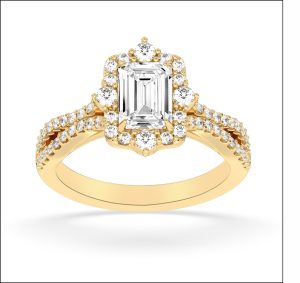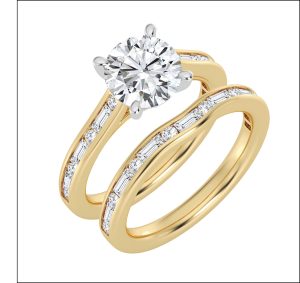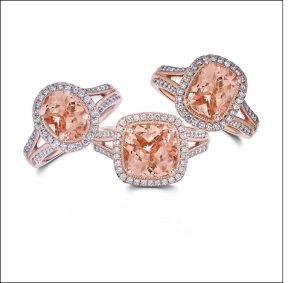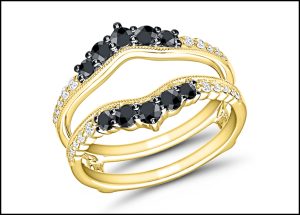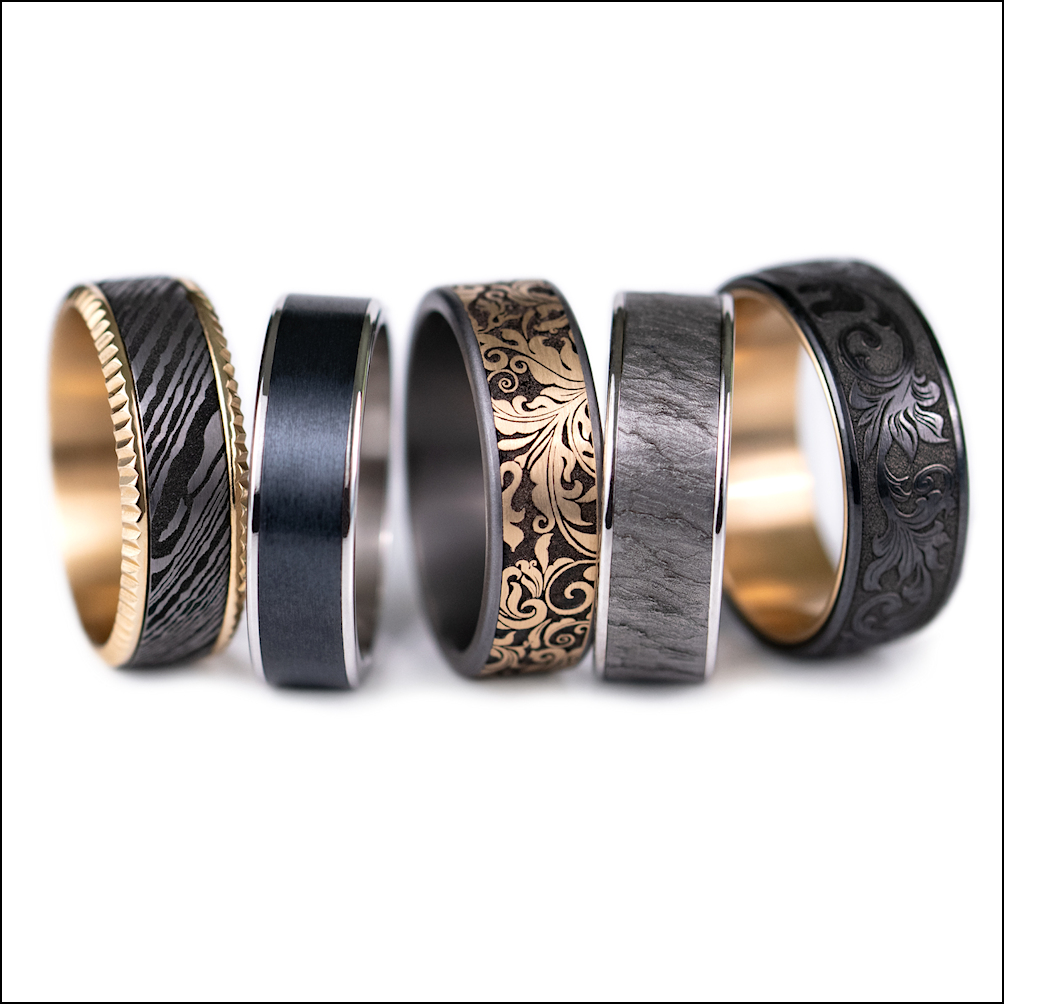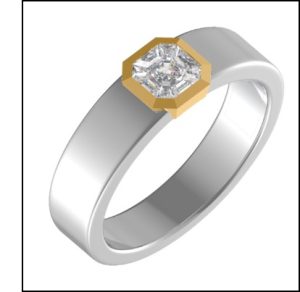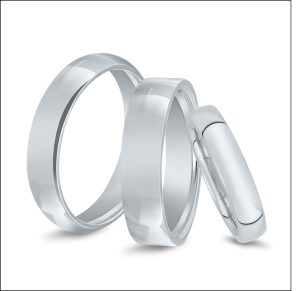The heat of the summer months ensures that people will dress in less, including lighter weight fine jewelry. When the temperatures rise, nobody wants to be weighed down, which is why sea-inspired gemstone hues and delicate yellow gold chains that complement bronzed skin tones.
That’s why Brevani’s Allison Peck, director of operations, sells dainty, layerable looks in summer—“because of the heat,” she says. “I don’t want to be walking around in 80-plus degree weather wearing a heavy gold chain that is going to stick to me once I start sweating,” she continues. “Light and airy is absolutely more comfortable!”
For metal type, many think silver for summer, but those styles tend to be chunkier than gold. When choosing gold jewelry, makers say that many shoppers go for yellow as opposed to white, so styles are not confused with sterling. “When someone spends money on a gold piece, they want it to look like gold,” adds Peck.
Perilynn Glasner, design and marketing director for Lali Jewels, has finer and daintier chains and pastel colors of gemstones to accommodate summer-minded shoppers. Of the latter, think aquamarine and blue topaz “because they match the beautiful hues of the ocean,” she says.
It’s a similar tale at Brevani—“Blue topaz has that summery vibe,” says Peck—and Shefi Diamonds, whose sales of blue topaz are strong for summer. “The ocean is where everyone wants to be in summertime,” adds Peck.
Chatham, meanwhile, has a more exotic blue option: lab-grown Paraíba-color spinel. “It’s a striking color that takes your mind straight to the Mediterranean waters, says Monica McDaniel, vice president, marketing, Chatham. “Like the highly desirable Paraíba tourmaline, this hue displays a richly saturated seafoam color.”
Other pastel shades like amethyst, peridot, white sapphire, white pearls, and rose quartz are also ideal for summer wardrobes.
“Any of the lighter color stones do well,” confirms Sam Hupp, vice president of sales and marketing for Paris 1901, a division of Prime Art & Jewel. “Seeing a multi-stone demi-fine bracelet in the summer is very common. Even earrings with multi-stone looks do well. Both tend to give a casual vibe that people embrace.”
Another color consideration? Tonal looks such as blue and purple. “These bring a nice, updated palette to the gemstone category,” explains Jessica Zerega, merchandising director, Goldstar Jewellery.
To no one’s surprise, beachy motifs sell well not just in cruise and resort areas but nationwide and year-round because of what they call to mind—vacation. From sea horses to seashells, flip flops, and more, there’s a symbol that will speak to every fan of summer. To wit, Shefi Diamonds’ Oceanity collection is “a beach lover’s paradise,” says Surbhi Jain, marketing director. Among its best sellers? Starfish and palm trees—“perfect for embracing the seaside spirit,” she says.
Non-water-inspired themes like flowers, butterflies, and the sun are also desirable classics for warm-weather wear.
“Summer brings sunny skies and warm nights!” says McDaniel. “That is why our Celestial Collection, comprising stars, the sun, and moon, are some of the most popular pieces during the summer months. Our 14k yellow gold sun pendant featuring lab-grown diamonds is dainty and feminine, the ideal motif to enhance any summer look.”
And while light and easy is the seasonal mantra from June through August, this doesn’t mean that layered looks are off the table; layers are fine with appropriate styles and body placements.
For example, multiple ear piercings are super popular and won’t weigh anyone down. Suggest this trio to clients—a stud earring, a delicate huggie, and a larger chunkier hoop earring, a threesome that “creates a nice balanced look,” observes Zerega.
Additionally, crop tops, capri pants, and sandals reveal more opportunities for bedazzled sections of the body in the form of anklets, toe rings, belly chains, and belly button rings. Bracelets and light pendants, too, are options, but rings are a harder summer sell. Why? Sunscreen application says Hupp.
“Often someone will have to remove the rings to apply, where with a pendant, bracelet, or anklet, they wouldn’t have to,” he says. “During summer months, most people want something that’s light, clean, and casual to wear on vacation.”
Summer jewels often become travel jewels, asserts Heather Brown, vice president of content and editorial for The Kingswood Company. She urges merchants to offer portable jewelry cleaning options such as wipes or a solution in a compact stick form. These, she maintains, “are easy to tuck into luggage or a purse to keep summer jewelry sparkling on the go.”
With the price of gold trading at more than twice that of platinum, many in jewelry have given the rare and pure naturally white metal more prominent placement in lines—and not just bridal.
“While some consumers may view platinum as a traditional metal to be used only for bridal jewelry, it’s actually great for everyday wear,” says Valerie Fletcher, vice president of design and product development for ODI. That’s why her firm recently unveiled a Platinum Classics collection containing diamond jewelry staples like tennis bracelets, hoops, halo pendants, and studs as well as hearts, crosses, and other fashion pendants.
Platinum’s positive attributes are abundant. It’s strong, denser and heavier than gold, won’t lose metal over time like karat-gold jewels, never requires rhodium plating because it is naturally white, and it’s hypoallergenic, making “it wearable for people with sensitive skin or allergies to metals that are found in gold alloys, adds Fletcher. “White gold is plated to look white and will need to be replated over time.”
On the flip side of all the praise is the long-repeated misconception that the metal scratches easily. That’s not true, says Rick Mulholland, sales manager of 41-year-old Novell Design Group. “Our experience is that platinum is fairly resistant to deep marks,” he says. “Minor scratches can be easily buffed out.”
And while manufacturing in platinum is more expensive and challenging than gold and requires excellent craftsmanship, the upside is the creation of “substantial and durable” jewels that will “hold stones securely and retain beauty and value over generations,” continues Fletcher.
Next stop for platinum jewelry? Family heirlooms status.
“It’s interesting—if you take the same ring and make it in both 18k white gold and platinum, at today’s metal markets, the final cost of the platinum ring will only be about 10-15% higher,” says Fletcher. “This is even with the higher purity, heavier metal weight, and more expensive labor. When you factor in the natural beauty, wearability, longevity and low maintenance of platinum, it becomes a very easy percentage to overcome.”
For sure, the cost difference between gold and platinum now is negligible. Manufacturers like Jeff Levitt of Cynergy Trading recall when a blank platinum mounting was three times the price of a blank 14k gold one.
“With the current upside-down metal market, the premium for platinum over 14k gold is the smallest I have ever seen, making platinum a superb choice—not only for superior quality but for value,” says the vice president of merchandising. “For these reasons we are seeing an increased interest in platinum not only for sold orders but also for stocked items.”
At 76-year-old Frederick Goldman, Inc., platinum has long had a place in every one of its bridal jewelry collections. So, it’s not surprising that its newest line, the Goldman Luxe Collection, also capitalizes on all the attributes the metal has to offer.
“We are targeting our higher-end customers with platinum engagement ring semi-mounts featuring significant center stones, starting at 2.00 carats,” says Tom Schwartz, vice president of marketing. “Additionally, we have introduced an updated assortment of platinum wedding bands featuring modern, architecturally influenced styles incorporating diamonds. Handcrafted in North America, each platinum band is designed to provide an elevated look and exude luxury, catering to the discriminating buyer.”
Many other manufacturers also use platinum in the commitment jewelry category—think Goldstar Jewellery, which uses it with better diamonds “for an elevated collection,” says Robyn Fields, vice president of sales. Ditto for IDDNY and its Moze bridal styles. “Platinum is perceived as special, and what is more special than your engagement ring?” queries Manan Mehta, business development manager.
Novell Design Group, too, has long championed the metal for its bridal collections. “It’s a first option for designs at our trunk shows and to retailers who prefer to stock live samples,” says Mulholland.
That’s why his firm recently unveiled the Solitaire Plus Collection of reimagined solitaire engagement rings offering twists on traditional looks and discretely placed diamond or colored gemstone accents that only the wearer sees. Novell loves platinum for its distinct properties, but Mulholland may be biased about its look. “Diamonds and colored gemstones simply look better when set in platinum,” he says.
Regularly clean your platinum jewels to keep them looking their best. Mulholland suggests mild soap and water while The Kingswood Company’s Heather Brown, vice president of content and editorial, advises using a professional ammoniated jewelry formula. “Send customers home with cleaner to keep a new ring sparkling,” she says.
The aquatic origins of cultured pearls make them the defacto gem of summer. Pearls are also a traditional look that’s being worn in more modern ways.
Lali Jewels’ Perilynn Glasner confirms that pearls, particularly cultured freshwaters in a variety of colors, are perfect for nearly all designs.
“Pearls are a classic and never go out of style since they have been modernized for today’s consumer,” she says. “We have a collection of multicolor pearls which have a soft elegance to them. This helps elevate your spring or summer style.”
As many know, 100% of the product produced by Imperial has pearls, from studs to fashion items.
“Many designs are influenced by trends in the jewelry world which we’ll interpret in pearl,” explains Kathy Grenier, vice president of business development. “We create specialty collections, such as Weddings, complete with display marketing.”
Manufacturer Brevani steers clear of classic pearl looks but does use the gem in nontraditional designs. They do so, according to Allison Peck, director of operations, to combat dated stereotypes. “It helps that recently pearls have been more mainstream, being worn by both men and women,” she says.
Phillip Gabriel Maroof, vice president of marketing and design for the Royal Chain Group, notes the company doesn’t use a lot of pearls in its karat-gold jewelry—“Less than 5% of our assortment contains pearls,” he says—but that figure is growing.
“We generally use freshwater pearls,” he continues. “After Harry Styles donned them, we think stereotypes have gone out the door! We modernize our pearl looks by utilizing them as accents in our gold jewelry, mixing them with trendy settings and combinations to make the stone more adaptable in fashion.”
Mastoloni Pearls’ company principal Fran Mastoloni agrees.
“There seems to be a common misconception about pearls, that they are not for everyone,” he says. His family’s 80-plus-year-old brand, however, has never viewed them as dated or for only one segment of the population. “Just as every pearl is distinct, so is the individual. There exists a pearl and pearl style for every person—from the conservative to the cutting-edge.”
New pearl jewelry designs touch on all the mainstream jewelry trends. Half-and-half necklaces containing pearls and other gems, or gold and silver links, are a hit among many. Maroof makes both paperclip necklaces and beaded numbers with pearls. Mastoloni recently debuted ribbed effects in gold with freshwater pearls and diamonds, while Imperial offers their interpretation of a bar-style necklace with their favorite gem.
Brevani’s recently unveiled freshwater pearl collection features pearls that are illusion-set with diamonds as well as new mother-of-pearl styles. Given they’re so new, retailer feedback isn’t yet available, but the Brevani team members are already fans. “The response from our office staff is extremely positive,” says Peck.
At Shefi Diamonds, pearls are part of its fashion-forward collections. These include pearls set with diamond-accented motifs like owls, snowflakes, starfish, and more. Plus, a new display program is on the horizon for clients who like the offerings.
Meanwhile, no one should forget that pearl jewelry requires cleaning, just like any other type of jewelry. It’s a point that, despite the popularity of pearls, says Heather Brown, vice president of content and editorial for The Kingswood Company, many do not know.
“Pearls, like other softer gemstones, should be cleaned with a gentle professional jewelry cleaning formula,” she explains. “Strung pearls should not be soaked in a cleaning formula, so use a jewelry cleaning stick or wipe. Providing education about how to safely clean purchases, plus offering the right products, is a win-win for jewelers and customers.”
While summer vacation plans are just heating up, retailers know they must keep the cooler weather months top of mind. Fourth-quarter sales will be here before you know it, and they account for a big chunk of annual revenue. To prepare for successful sales seasons, store owners must start early and make thoughtful plans long before the holidays arrive.
To do so, makers and merchants need to consider every aspect of seasonal prep, from buying the right inventory to having the most memorable marketing campaigns to effectively using every tool in the marketer’s arsenal to drive shoppers online and in store to buy gifts. To get products in hand on time, Heather Brown of The Kingswood Company urges retailers to ask manufacturers “when orders must be placed to receive shipments in time for holiday sales,” says the vice president of content and editorial.
For great marketing campaigns, make sure product and lifestyle (model) photography is professionally executed, and use the visuals wisely to command attention. Ostbye’s merchandise manager Theresa Namie finds that “making Reels with everyday people” captures many eyeballs.
Finally, use the right tools to reach shoppers. Worthwhile resources include social media, especially Instagram, conversational and engaging written posts that ignite viewers’ curiosity—as opposed to hard sells—as well as emotion-inspiring and romantic product back stories. Creating low-key settings that allow shoppers to peruse products while enjoying another primary activity (think spa treatments or vintage car shows) are also encouraged.
“Bring the customer and the product together,” recommends Sam Hupp, vice president of sales and marketing for Paris 1901. “Now sales are about providing a value for the customer’s time.”
Hot Sellers for 4th Quarter
By this point in the year, many holiday inventories have already been ordered, with merchants hoping their selections will sell well across the product categories. While some jewelry choices never surprise, many more are often educated gambles by makers and merchants.
“We look at everything in the jewelry market, magazines, trade shows, runway shows, retail stores, employees, reality TV, and social media,” says Theresa Namie, marketing manager of Ostbye. “Then we focus in on what would be special enough to last longer than a seasonal trend and would price well in that category.”
Her best-sellers routinely include a Christmas cross along with new looks with wide appeal (think flowers) to present low-risk options. Happily, retailer requests can skew more adventurous—like this year as store owners have asked for bold gold, gemstones, and a new elevated silver and diamond line, she adds.
“Retailers have been asking for yellow gold in fashion jewelry, elevated silver designs, color, organic motifs, signet rings, and wide band designs,” says Namie.
At Paris 1901, Sam Hupp, vice president of sales and marketing, is hoping that two new collections will speak to customers and their clients. Hupp has a men’s line called ETHOS and a new lab-grown diamond line called Monte Luna, with styles designed to appeal to demi-fine jewelry fans. The latter was created specifically for consumers who are “leaning into jewelry at a price to enhance their wardrobes,” he says.
“You can turn a look into something new with amazing new diamond and ruby earrings,” he continues. “Or adding layered bracelets can change the appearance of a basic shirt.”
His firm’s 2024 offerings already have an advantage because of his team’s keen product analyses.
“We have a few incredible men’s pendants and chains that are already beating last year’s sales,” he says. “For women, our diamond accent demi-bracelets will be the go-to for approachable jewelry gift giving.”
His retailers are also asking for romanceable product and stories to engage customers. These will help build trust and keep shoppers in stores longer, ultimately leading to improved sales. For sure, sharing insights, market trends, and successful concepts are critical for all.
“The days of everyone against everyone are over since the pandemic,” observes Hupp. “Now, we need to encourage and help each other find success. Ultimately, market growth helps us all.”
Imperial Pearl is hoping that more 4th quarter sales will take shape in the form of some of its newest collections. Think silver and karat gold, pearls and flowers, 14k gold and pearls, and a seven-piece sterling silver capsule collection.
Goldstar Jewellery’s Steven Lerche, chief operating officer, hopes his firm’s relaunch of mined diamonds will be appreciated. “We need to get the consumer re-excited about natural diamonds,” he says. There will still be lab-created diamonds in assortments, however, due to consumer demand and flexibility of styling.
“Lab-created diamonds have made unattainable price points attainable with the use of small fancies and creative shapes of diamonds that would normally only be accessible to the affluent who shopped top brands,” he says.
Aneri Jewels is banking on seasonal-themed motifs to resonate with shoppers. Director Nancy Italia-Gajera says those items will “evoke the spirit of celebration and gifting.” That’s why she anticipates her firm’s Snowflake diamond pendant will be a 4th quarter hit. That, along with new gemstone cuts and color combinations, will “keep our collections fresh and appealing to evolving consumer tastes,” she adds.
KGS Jewels is banking on medallion pendants in 14k gold with diamond accents to land in the holiday gift piles of many, while Shefi Diamonds thinks its yellow diamonds, yellow textured gold, enamel, and rubellite tourmaline offerings will sell well.
“The secret to crafting jewelry that everyone wants is sticking to timeless designs,” reveals marketing director Surbhi Jain. “Classics never lose their appeal.”
And to serve as the cherry on top of jewelry gifts, The Kingswood Company suggests retailers add cleaning products to inventories as stocking stuffers or teachers’ or hostess gifts. “Jewelry care and cleaning products provide the perfect add-on to holiday sales,” says Heather Brown, vice president of content and editorial.
Magical Product Campaigns
Those returning from North America’s biggest trade jewelry buying experience will have more than suitcases in hand; they’ll also have orders for what merchants’ hope will be hot sellers for the holidays. But inventory is just one part of the 4th quarter equation—another is marketing and how to get clients into stores. To make that happen, manufacturers make myriad visual tools available for customers to use.
Imagery is everything—from lifestyle model shots to still life to styles on white (also called pack shots), consumers need to see the product from many angles to drive home a desire to own it. Marketing surrounding new product releases can involve these three types of photography for each campaign. Frequency of efforts varies.
At Ostbye, Merchandise Manager Theresa Namie has three product releases a year, all with its own creative. At Paris 1901, full campaigns are shot once a year but are supplemented by “smaller launches with updated assets,” says Sam Hupp, vice president of sales. At KGS Jewels, new visuals are shot monthly, while Aneri Jewels shoots four times a year.
“We create new campaign imagery quarterly to keep our marketing fresh and aligned with seasonal trends,” explains Nancy Italia-Gajera, Aneri’s director.
Heather Brown of The Kingswood Company is also well-versed in the importance of visuals.
“We understand that providing beautiful high-end imagery for our full production line is imperative,” says the vice president of content and editorial. “Our image development is handled in-house by our talented design team.”
Other opinions vary on whether to handle the imagery in house or outsource it. Namie does both depending on the tasks at hand. “For us it is just a matter of who can do [the job] best,” she explains. Most interviewees execute creative within company walls for cost-effectiveness and better control over brand imaging.
To create effective campaigns, consider a color scheme that will work across all four seasons. Effects and props should be simple. “We strive to keep the jewelry prominent by not using too busy of backgrounds,” observes Namie.
Consistency and a thoughtful approach are also key. According to Hupp, don’t break out the 5 ct. diamond rings for a message that’s supposed to speak to younger clients. “Know the end purpose before developing any new assets,” he says.
Italia-Gajera urges peers to remember the most important aspect of new brand imagery— “Its ability to evoke emotion and convey the essence of the brand,” she says. Further, visuals should “resonate with the target audience and effectively communicate brand values.”
Once visuals are complete, put them into action. Photography is so important for use in ads, signage, and e-blasts as well as on websites and across social media platforms.
Namie creates content shared in weekly texts and/or emails and has marketing resources available online, while Hupp develops assets for partners to use on social media, in email, and for banner ads. And based on sales reports, the marketing team at Shefi Diamonds crafts “stunning” social media posts for retailers on request, according to marketing director Surbhi Jain.
“Keep your audience interested!” urges Namie. “Attract, not sell.”
A Marketer’s Toolbox
Reach is everything when it comes to marketing, and manufacturers have plenty of ideas on how clients can achieve their goals. Not surprisingly, social media—and specifically, Instagram—tops the list of most important tools to use.
“Social media is the number one way to directly receive and give feedback from your customers,” explains Sam Hupp, vice president of sales and marketing for Paris 1901. “Bringing along your customers in your business journey is necessary to develop a ‘genuine’ reputation. You build trust when you share your successes and struggles. Sometimes jewelers don’t realize that a social media account isn’t simply another advertising platform, rather it should be positioned as a window to the day-to-day business.”
Nearly every expert interviewed insist that retailers use Instagram, calling it a powerful, must-use tool.
“An active account … helps leverage visual storytelling, foster engagement, expand reach, and facilitate direct sales, ultimately driving growth and success for the business,” says Surbhi Jain, marketing director of Shefi Diamonds.
How you craft messages counts, too. Hupp paints a vivid example for those unveiling new collections. “They can be promoted as ‘Come see our new collection’ or ‘I can’t believe we were fortunate to get to work with (collection owner) and bring (collection) to our showcases,’” he says. “‘The way they’ve done (fill in the blank) is so amazing to us.’ Option A is an ad, direct and a clean CTA, but option B provides an indirect CTA and engages the curiosity of the consumer.”
Successful initiatives can also include Facebook and Instagram Lives, notes Theresa Namie, merchandise manager of Ostbye.
“On these, retailers can talk about what is trending, fashion accessorizing, and teaching about gemstones and diamonds—all things that attract interest instead of just pure selling,” she says.
More examples that get results can also (ironically) minimize the focus of the product for sale.
“There are jewelers in the Phoenix area that partner with classic car groups,” observes Hupp. “They will bring in watch vendors for pop-ups while having the classic cars shown in their parking lots on certain Saturdays. The days of the hard sell are over.”
Still more exemplary moves include on-target signage and storytelling. Nancy Italia-Gajera, director, Aneri Jewels, recalls one campaign that featured “heartwarming stories of love and connection, paired with stunning visuals of our jewelry,” she says. “This resonated deeply with customers and resulted in increased engagement and sales.”
Other tips to strengthen marketing include visualization and tenacity. Namie recalls recent advice from a marketing guru whom she heard speak: “Write down three adjectives that describe your brand, would your employees and customers say the same thing?” she asks. “Build your store personality around those that you want to reach and live your brand. Restart. Refresh. Refocus. As many times as you need, just don’t give up.”
Know your customer and how they like to be communicated with, offer customized content and personalization, foster transparency and trust, and “engage in value-driven marketing that resonates with customers’ beliefs,” says Jain.
More toolbox tactics should include Reels, holiday fliers, and other creative that celebrates the products. “Audiences today want to see real-life images,” insists Namie.
“It’s business suicide if a wholesaler isn’t providing all the assets (digital and physical) to customers to allow them to market products,” adds Hupp. “Give clients the tools and let them speak to their clientele the best way they know how. Often you see larger vendors forcing a direction. When that happens, the messages are often lost due to the variation in the markets. Give retailers options in their assets to use what they believe works best.”
Private-label products and created content, including how-to’s and trends, can also appeal to customers, says Heather Brown, vice president of content and editorial for The Kingswood Company.
“When consumers return home with a branded product … it’s like taking out a mini billboard in their home,” she says with her company’s jewelry cleaning products in mind. “Our company offers customers a number of resources to support their marketing efforts.”
Reach is everything when it comes to marketing, and manufacturers have plenty of ideas on how clients can achieve their goals. Not surprisingly, social media—and specifically, Instagram—tops the list of most important tools to use.
“Social media is the number one way to directly receive and give feedback from your customers,” explains Sam Hupp, vice president of sales and marketing for Paris 1901. “Bringing along your customers in your business journey is necessary to develop a ‘genuine’ reputation. You build trust when you share your successes and struggles. Sometimes jewelers don’t realize that a social media account isn’t simply another advertising platform, rather it should be positioned as a window to the day-to-day business.”
Nearly every expert interviewed insist that retailers use Instagram, calling it a powerful, must-use tool.
“An active account … helps leverage visual storytelling, foster engagement, expand reach, and facilitate direct sales, ultimately driving growth and success for the business,” says Surbhi Jain, marketing director of Shefi Diamonds.
How you craft messages counts, too. Hupp paints a vivid example for those unveiling new collections. “They can be promoted as ‘Come see our new collection’ or ‘I can’t believe we were fortunate to get to work with (collection owner) and bring (collection) to our showcases,’” he says. “‘The way they’ve done (fill in the blank) is so amazing to us.’ Option A is an ad, direct and a clean CTA, but option B provides an indirect CTA and engages the curiosity of the consumer.”
Successful initiatives can also include Facebook and Instagram Lives, notes Theresa Namie, merchandise manager of Ostbye.
“On these, retailers can talk about what is trending, fashion accessorizing, and teaching about gemstones and diamonds—all things that attract interest instead of just pure selling,” she says.
More examples that get results can also (ironically) minimize the focus of the product for sale.
“There are jewelers in the Phoenix area that partner with classic car groups,” observes Hupp. “They will bring in watch vendors for pop-ups while having the classic cars shown in their parking lots on certain Saturdays. The days of the hard sell are over.”
Still more exemplary moves include on-target signage and storytelling. Nancy Italia-Gajera, director, Aneri Jewels, recalls one campaign that featured “heartwarming stories of love and connection, paired with stunning visuals of our jewelry,” she says. “This resonated deeply with customers and resulted in increased engagement and sales.”
Other tips to strengthen marketing include visualization and tenacity. Namie recalls recent advice from a marketing guru whom she heard speak: “Write down three adjectives that describe your brand, would your employees and customers say the same thing?” she asks. “Build your store personality around those that you want to reach and live your brand. Restart. Refresh. Refocus. As many times as you need, just don’t give up.”
Know your customer and how they like to be communicated with, offer customized content and personalization, foster transparency and trust, and “engage in value-driven marketing that resonates with customers’ beliefs,” says Jain.
More toolbox tactics should include Reels, holiday fliers, and other creative that celebrates the products. “Audiences today want to see real-life images,” insists Namie.
“It’s business suicide if a wholesaler isn’t providing all the assets (digital and physical) to customers to allow them to market products,” adds Hupp. “Give clients the tools and let them speak to their clientele the best way they know how. Often you see larger vendors forcing a direction. When that happens, the messages are often lost due to the variation in the markets. Give retailers options in their assets to use what they believe works best.”
Private-label products and created content, including how-to’s and trends, can also appeal to customers, says Heather Brown, vice president of content and editorial for The Kingswood Company.
“When consumers return home with a branded product … it’s like taking out a mini billboard in their home,” she says with her company’s jewelry cleaning products in mind. “Our company offers customers a number of resources to support their marketing efforts.”
Those returning from North America’s biggest trade jewelry buying experience will have more than suitcases in hand; they’ll also have orders for what merchants’ hope will be hot sellers for the holidays. But inventory is just one part of the 4th quarter equation—another is marketing and how to get clients into stores. To make that happen, manufacturers make myriad visual tools available for customers to use.
Imagery is everything—from lifestyle model shots to still life to styles on white (also called pack shots), consumers need to see the product from many angles to drive home a desire to own it. Marketing surrounding new product releases can involve these three types of photography for each campaign. Frequency of efforts varies.
At Ostbye, Merchandise Manager Theresa Namie has three product releases a year, all with its own creative. At Paris 1901, full campaigns are shot once a year but are supplemented by “smaller launches with updated assets,” says Sam Hupp, vice president of sales. At KGS Jewels, new visuals are shot monthly, while Aneri Jewels shoots four times a year.
“We create new campaign imagery quarterly to keep our marketing fresh and aligned with seasonal trends,” explains Nancy Italia-Gajera, Aneri’s director.
Heather Brown of The Kingswood Company is also well-versed in the importance of visuals.
“We understand that providing beautiful high-end imagery for our full production line is imperative,” says the vice president of content and editorial. “Our image development is handled in-house by our talented design team.”
Other opinions vary on whether to handle the imagery in house or outsource it. Namie does both depending on the tasks at hand. “For us it is just a matter of who can do [the job] best,” she explains. Most interviewees execute creative within company walls for cost-effectiveness and better control over brand imaging.
To create effective campaigns, consider a color scheme that will work across all four seasons. Effects and props should be simple. “We strive to keep the jewelry prominent by not using too busy of backgrounds,” observes Namie.
Consistency and a thoughtful approach are also key. According to Hupp, don’t break out the 5 ct. diamond rings for a message that’s supposed to speak to younger clients. “Know the end purpose before developing any new assets,” he says.
Italia-Gajera urges peers to remember the most important aspect of new brand imagery— “Its ability to evoke emotion and convey the essence of the brand,” she says. Further, visuals should “resonate with the target audience and effectively communicate brand values.”
Once visuals are complete, put them into action. Photography is so important for use in ads, signage, and e-blasts as well as on websites and across social media platforms. Namie creates content shared in weekly texts and/or emails and has marketing resources available online, while Hupp develops assets for partners to use on social media, in email, and for banner ads. And based on sales reports, the marketing team at Shefi Diamonds crafts “stunning” social media posts for retailers on request, according to marketing director Surbhi Jain.
“Keep your audience interested!” urges Namie. “Attract, not sell.”
Jewelry exists in people’s lives as luxury goods. Jewelry stores with beautiful interior design and decoration style are more popular amongst most luxury goods consumers. Everyone has different ideas on how to create their store. The jewelry store can be made into many styles but, no matter what kind of style you choose, it must be high-end to sell jewelry.
Some jewelry store owners have their own concepts for their stores to make them special and functional. A good store layout and special services can attract many customers. Take a look at some modern interior design of jewelry stores with functional areas. Jewelry stores generally use luxurious decoration design, but this store adopts a modern, simple style. It provides customers with a sense of elegance and grace and improves the consumer experience of shopping. I designed Don Basch Jewelers for their valued customer from “Concept to Completion.”
Jewelry Store Exterior Design: The outdoor design includes the door head design of the storefront, the window, and so on. The design of the jewelry store should be novel and be able to attract the attention of consumers. The design of the windows is basically set with props and best-selling jewelry. This jewelry store’s exterior design is simple and without other decoration. Its color is unified. The signboard has a 3-D luminous logo at the store’s middle. Because the exterior design is without other decorations, the logo and consumers can see it easily. In this way, the luminous logo can leave people impressed and remember the store directly. Because the exterior glass is not a wall, it can pique potential consumers’ curiosity. See picture below of Don Basch exterior building.

Jewelry Store Layout Display: For jewelry stores, there is a need to be particular about the layout. A suitable layout can make people feel comfortable and relaxed. The layout design requires an arrangement of space and area. Some jewelry owners like to divide the store into three different areas. The right side of the store is the main part to display jewelry. The middle area is the living room style (customer resting area) with chairs, TV, fireplace, tables with a bar to treat their consumers, and other side area is the reception room. These basic areas are interconnected and lead consumers to come into every room freely. The store is functional because of the different services. It is unique to other common jewelry stores as it does not include the back-office section. This approach makes the layout of the store very comfortable. The jewelry owner is full of imagination, and jewelry store interior designers transform their ideas into reality. See picture below of Don Basch living room area.
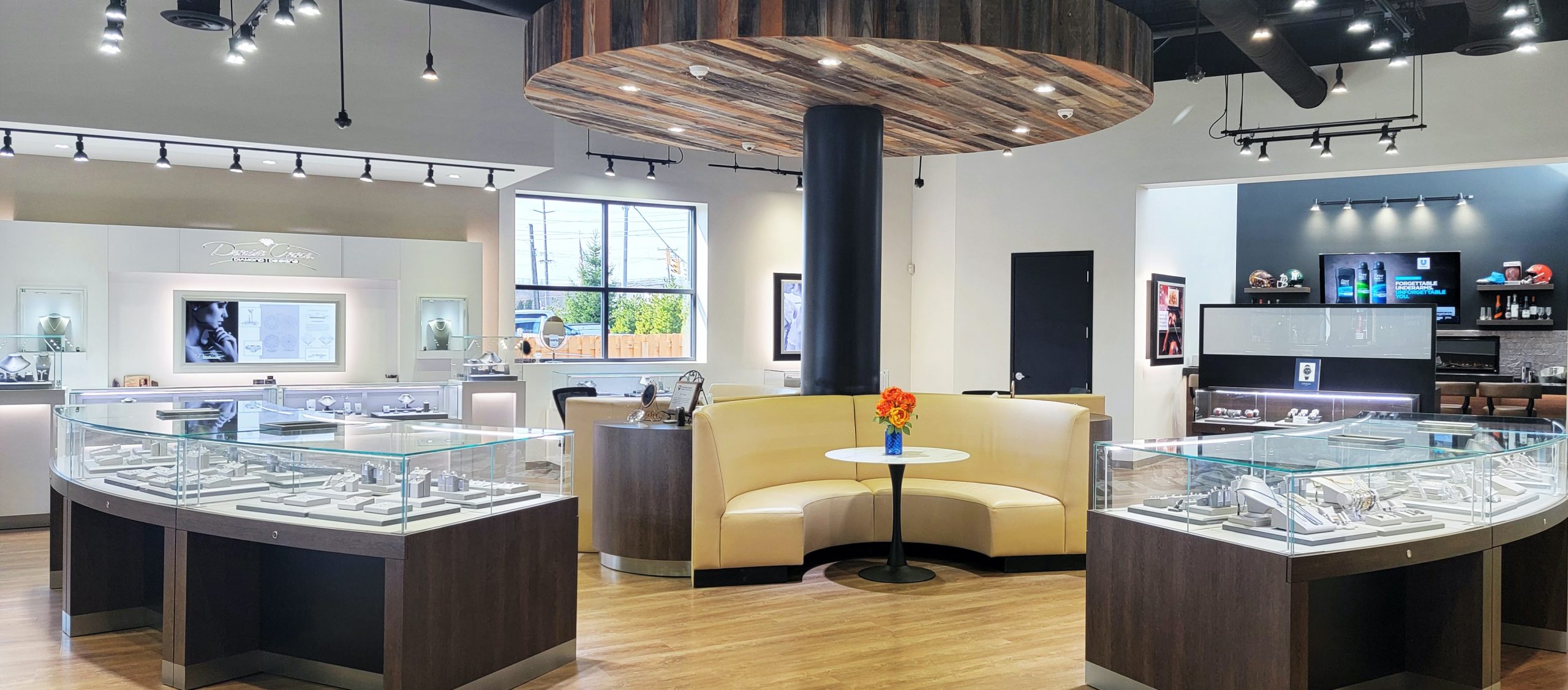
Interior Design: If the jewelry store has been divided into three different parts, then every area has its own interior decoration design. However, the overall style of the store is the same throughout. The main color tone of the shop is white and requires that every part has its relevant features. Let’s look at the rooms’ design one by one. The furniture is an important part of the store. For the jewelry display area, quality jewelry cases are essential, which follow the interior design style. The cabinets are a warm brown with glass layers to hold the products. The 3-D logo is on the logo wall usually near the POS. This can enhance the store’s branding. See picture below of Don Basch Jewelers POS area with logo.

The proper LED lights are at the top of the ceiling shine on the jewelry in their cases. The cabinet bottom has storage space for accessories, such as the jewelry packaging bags. Jewelry store owners can also put some countertop cases to show products near the bar counter. The living room area, including bar counter, also has storage space. At the showcase area, consumers can enter from another area of the store. The jewelry store, in addition to the display part, also has another a customer resting area. This leaves many spaces for people to see the jewelry, especially in VIP rooms.
The food area is a special part of the store. The owner considers the consumer’s experience and offers food service. The staff can make beverages and snacks to treat the consumers. The furniture for the living room area is comfortable and consumers can go into the jewelry room and see jewelry from the living room. It is a very effective and promotional way of doing business.
VIP Room: This room can treat many customers, especially VIP customers. The ceiling and wall interior design and decoration is the same as the jewelry room. The room may have a window, too. The consumer can speak with the manager or sales personnel, as well as the jewelry customization services team. The table and chairs area can also be put at the front, near the door. An individual reception room can let people know the jewelry store regards them as valued consumers and offers exceptional service and a nice shopping atmosphere. See picture below of Don Basch Jewelers Diamond/ VIP room.
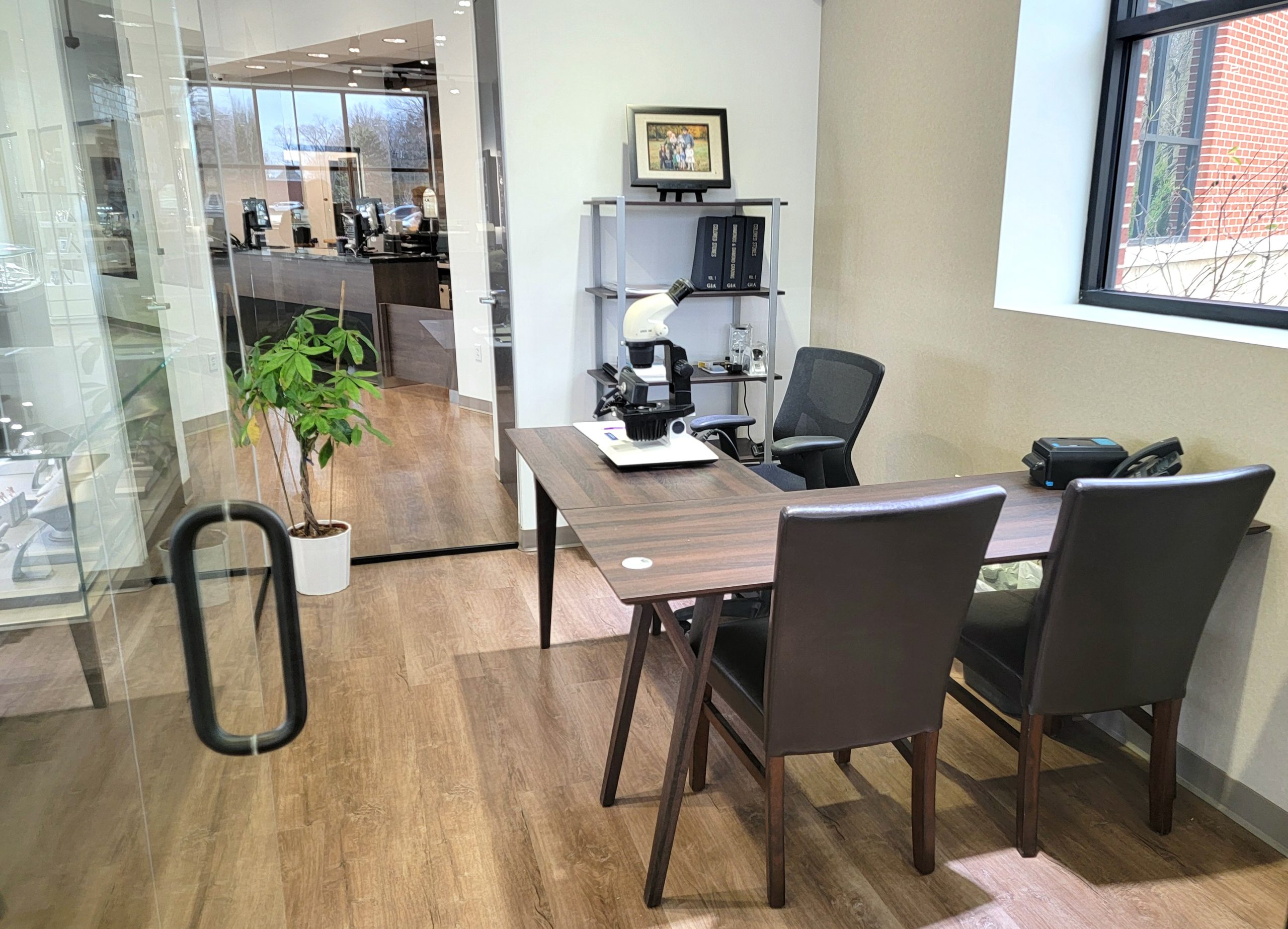
Jewelry Display Fixture: For the jewelry store, the display fixture cases vary in style. The owner can accentuate the store’s style with showcases, counters, cabinets etc. with the interior designer. There are so many styles to choose from. But if you want them with your own features, a jewelry store’s interior design is the best way. The display showcase carries high-grade jewelry, so the display fixtures can’t be out-fashion and low level. When consumers can’t see the jewelry closely and clearly, they can feel that the jewelry may be at a poor level directly from the showcase. The display furniture can also affect the initial consumer’s impression just by passing the shopping window, because they can see the store’s inside layout, interior design, and display furniture. See picture below of Don Basch Jewelers circular display area for jewelry.
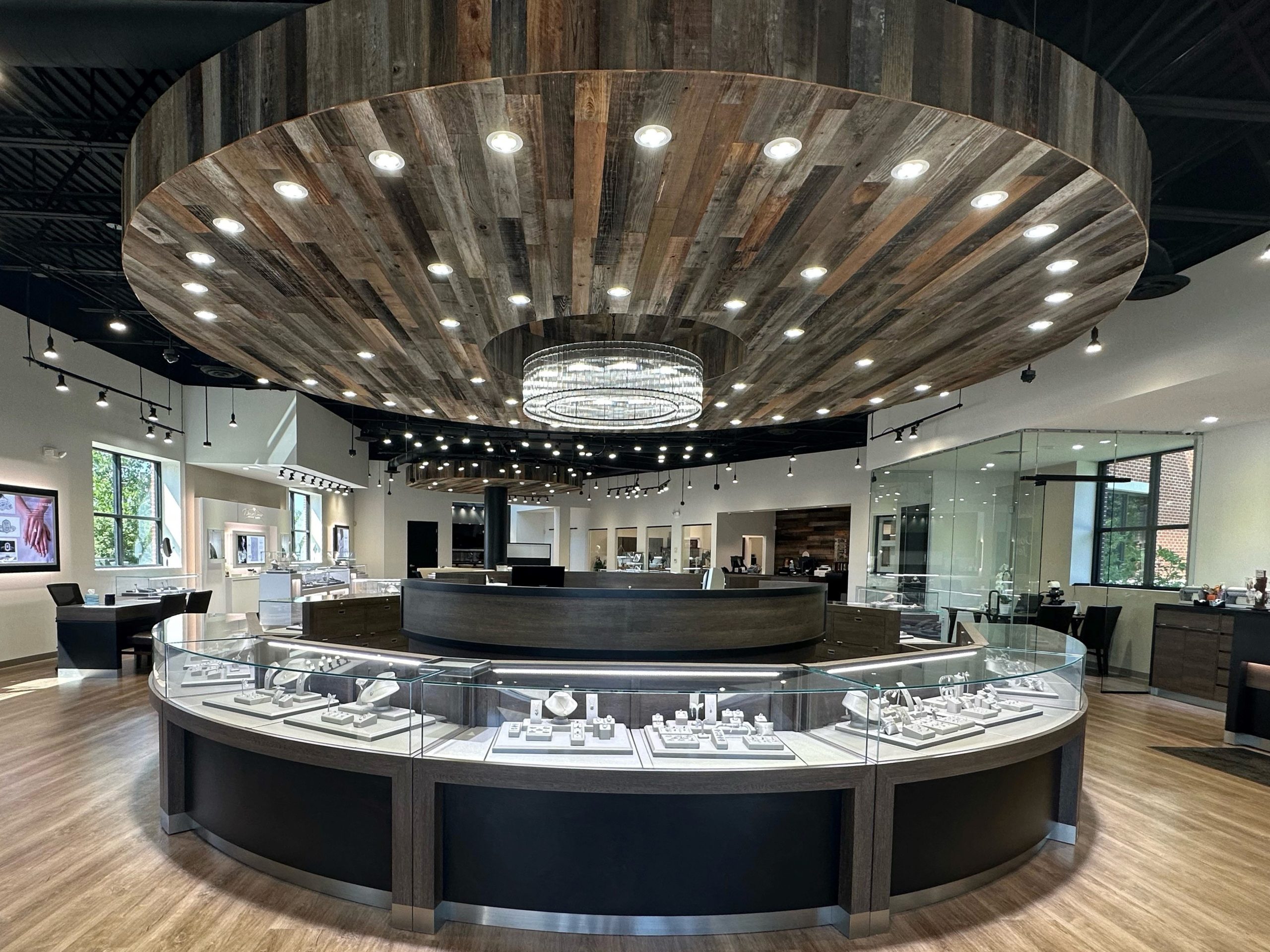
Conclusion: All creative imagination of the jewelry store’s owner can come true through with the correct interior design process and production. The store’s display fixture, style, atmosphere, color, interior designers can make it unique for the owner and competitive in the local community, as well as build the store’s brand in the minds of consumers.
About the Author: Leslie McGwire™ has over 35 years in business development, interior design, equipment, furniture sales and marketing services in retail and jewelry-based businesses. Leslie has won over 25 national design awards, including the prestigious Salon Today and INSTORE Jewelry Store awards. Leslie has a true passion for business, design for the jewelry and retail industries. Visit lesliemcgwire.com for more information.
By this point in the year, many holiday inventories have already been ordered, with merchants hoping their selections will sell well across the product categories. While some jewelry choices never surprise, many more are often educated gambles by makers and merchants.
“We look at everything in the jewelry market, magazines, trade shows, runway shows, retail stores, employees, reality TV, and social media,” says Theresa Namie, marketing manager of Ostbye. “Then we focus in on what would be special enough to last longer than a seasonal trend and would price well in that category.”
Her best-sellers routinely include a Christmas cross along with new looks with wide appeal (think flowers) to present low-risk options. Happily, retailer requests can skew more adventurous—like this year as store owners have asked for bold gold, gemstones, and a new elevated silver and diamond line, she adds.
“Retailers have been asking for yellow gold in fashion jewelry, elevated silver designs, color, organic motifs, signet rings, and wide band designs,” says Namie.
At Paris 1901, Sam Hupp, vice president of sales and marketing, is hoping that two new collections will speak to customers and their clients. Hupp has a men’s line called ETHOS and a new lab-grown diamond line called Monte Luna, with styles designed to appeal to demi-fine jewelry fans.
The latter was created specifically for consumers who are “leaning into jewelry at a price to enhance their wardrobes,” he says.
“You can turn a look into something new with amazing new diamond and ruby earrings,” he continues. “Or adding layered bracelets can change the appearance of a basic shirt.”
His firm’s 2024 offerings already have an advantage because of his team’s keen product analyses.
“We have a few incredible men’s pendants and chains that are already beating last year’s sales,” he says. “For women, our diamond accent demi-bracelets will be the go-to for approachable jewelry gift giving.”
His retailers are also asking for romanceable product and stories to engage customers. These will help build trust and keep shoppers in stores longer, ultimately leading to improved sales. For sure, sharing insights, market trends, and successful concepts are critical for all.
“The days of everyone against everyone are over since the pandemic,” observes Hupp. “Now, we need to encourage and help each other find success. Ultimately, market growth helps us all.”
Imperial Pearl is hoping that more 4th quarter sales will take shape in the form of some of its newest collections. Think silver and karat gold, pearls and flowers, 14k gold and pearls, and a seven-piece sterling silver capsule collection.
Goldstar Jewellery’s Steven Lerche, chief operating officer, hopes his firm’s relaunch of mined diamonds will be appreciated. “We need to get the consumer re-excited about natural diamonds,” he says. There will still be lab-created diamonds in assortments, however, due to consumer demand and flexibility of styling.
“Lab-created diamonds have made unattainable price points attainable with the use of small fancies and creative shapes of diamonds that would normally only be accessible to the affluent who shopped top brands,” he says.
Aneri Jewels is banking on seasonal-themed motifs to resonate with shoppers. Director Nancy Italia-Gajera says those items will “evoke the spirit of celebration and gifting.” That’s why she anticipates her firm’s Snowflake diamond pendant will be a 4th quarter hit. That, along with new gemstone cuts and color combinations, will “keep our collections fresh and appealing to evolving consumer tastes,” she adds.
KGS Jewels is banking on medallion pendants in 14k gold with diamond accents to land in the holiday gift piles of many, while Shefi Diamonds thinks its yellow diamonds, yellow textured gold, enamel, and rubellite tourmaline offerings will sell well.
“The secret to crafting jewelry that everyone wants is sticking to timeless designs,” reveals marketing director Surbhi Jain. “Classics never lose their appeal.”
And to serve as the cherry on top of jewelry gifts, The Kingswood Company suggests retailers add cleaning products to inventories as stocking stuffers or teachers’ or hostess gifts. “Jewelry care and cleaning products provide the perfect add-on to holiday sales,” says Heather Brown, vice president of content and editorial.
Each year, the Las Vegas jewelry shows held in late May and early June are a must-attend for many North American jewelers. It’s the best time for merchants to see what’s new firsthand and decide what to buy and position for fourth-quarter sales.
“Our new collections are based on multiple factors like current market trends, data analysis of product we sell through, the current economic climate, and a deeper understanding of our inventory,” explains Monica McDaniel, vice president, Chatham.
New fashion collections from manufacturers—including Plumb Club members—will be rich in colored gemstones, lab-grown ones from Chatham, and a host of mined options from others. Color has also made its way into the wedding jewelry category as center stones and band accents. And not surprisingly, lab-grown diamonds, too, have an important place in some new lines.
As retailers prepare their open-to-buy plans for Sin City, know that suppliers are eager to assist. Bring your shopping lists but also your ideas and explore how suppliers can help you drive more sales.
“We listen to our retailers and produce solutions to their needs,” says Rick Mulholland, sales manager, Novell Design Studio.
Jennifer Dressing, senior vice president of merchandising and product development, KP Sanghvi, is equally prepared.
“We have a constant flow of jewelry coming out of our model-making department,” she says. “The possibilities are endless.”
Stocking Your Market
While JCK Las Vegas is weeks away, jewelry makers have been hard at work for months in preparation. Retailers’ options for new inventory will be abundant, from bridal to fashion and men’s collections; those interviewed for this article cite merchant and consumer interest in these directions as the driving force for manufacturing decisions.
To start, SHR Jewelry Group is capitalizing on the men’s jewelry phenomenon with a celebrity hook. Its new Marc Anthony/Bulova Jewelry Collection will feature watches and jewelry with “a shared cross-generational love of music, innovative design, and an artistic spirit that is bold at heart,” explains Scott H. Rauch, president and CEO. Expect edgy, free-spirited, and refined designs.
“The collection is a powerful symbol of self-expression and personal style embodying Marc’s bold confidence and taste for luxury,” he continues. “The line is in sterling silver, and retail prices range from $195–$1,295.”
At bridal jewelry house Novell Design Studio, show attendees can check out its new lightweight platinum wedding bands. “With the cost of platinum dropping, our men’s lightweight platinum designs are the better choice for a white metal,” explains Rick Mulholland, sales manager.
Novell will also unveil a new lab-grown diamond jewelry collection; retailers have been asking for one for upwards of a year. Styles will differ from what’s in the core (mined) diamond collections “so there’s no confusion over whether a popular style has lab-grown or natural stones,” adds Mulholland.
More bridal newness includes clusters and mine-to-market stone origins, among others.
Asian Star Group’s Erica Wadia reveals that her firm will unveil a “baby diamond bridal” cluster head that gives a look that is four times bigger than the carat weight. Rings with total diamond carat weights from 0.20–0.375 will be available in round and fancy shapes.
“We understand the importance of providing fresh and appealing options for retailers who do not currently promote lab diamonds, and our diamond baby bridals are crafted with this in mind,” she says. “We are committed to ensuring that the cluster style remains popular and relevant by infusing it with new elements that add excitement and allure.”
KP Sanghvi will unveil a trend-inspired bridal collection with mine-to-market diamonds thanks to the company’s close work with De Beers and its Origin and Tracr platforms.
IDD Luxe will debut additions to its Moze Bridal collection, including three-stone and anniversary rings and eternity bands. The company is also beefing up its Skyset Lab Fashion line and adding family-inspired pieces, new link numbers, and more SKUs to its best-selling Flexie collection.
Asian Star’s fashion-forward jewels, meanwhile, will feature vintage-inspired pieces with Big Three gemstones and diamonds. “These will embody the allure of bygone eras while offering a contemporary twist,” she says.
KP Sanghvi’s fashion items include bracelets with unique clasps, metal colors, and two-stone styles that retail for $499 to $2,999. “We want these fun bracelet designs to inspire how each person defines their relationship,” notes Jennifer Dressing, senior vice president of merchandising and product development.
Beaded designs will also have a presence. Think karat gold diamond-cut and polished styles from Royal Chain Group and gemstone beads from Shefi Diamonds. Royal Chain is also bringing puffy electroform earrings and more chains—all designed to layer nicely. “They complement each other and come together in layered looks,” says Phillip Gabriel Maroof, vice president of marketing and design.
Shefi’s Surbhi Jain, marketing director, says enamel and more gemstones, such as bands in yellow gold and rubellite tourmaline, will also be in cases.
The biggest colored gemstone offerings of all, however, will likely originate from Chatham, Inc. Three new collections of lab-grown gemstones will debut in Las Vegas, maintains Monica McDaniel, vice president. The first is Legacy, made in 18k gold with classic gems and diamonds, and it aims to appeal to an upscale clientele. A second, kaleidoscope-inspired, collection has fancy-shape lab-grown diamonds in sizes of 0.25 ct.–1.0 ct. with lab-grown colored gemstones. A third collection is an extension of its Color Fashion line, containing exclusive gem cuts like flame in the full spectrum of Chatham gem materials.
Finally, The Kingswood Company will offer a new Clean + Care® retail fixture program, giving store owners a more “sophisticated solution for displaying jewelry care products,” says Heather Brown, vice president of content and editorial. “Three unique models are available in varying footprints, aesthetic styles, and visual merchandising plans and are available to both private-label customers and those who offer the Clean + Care® product line,” she adds.
I Do Dream Rings
Given that engagement and commitment rings are perennial best-sellers in many stores, this category has no shortage of new designs. While there will be plenty to see at JCK Las Vegas, some manufacturers offer a sneak peek here.
Asian Star Group has been super busy; in the past six months, it has “introduced more than 250 new bridal designs,” according to Erica Wadia, vice president of marketing and corporate communication. This sea of styles also allows buyers to pick and choose parts between rings to make custom ones. Options include hidden halos—“in between the prongs or around the prongs,” she notes—French pavé on shanks and fancy-shape side stones, even lesser-known Cadillac cuts and trapezoids.
Coincidentally, KP Sanghvi has also created 250 new designs—“From high-end trend bridal to mid-range classic styling,” says Jennifer Dressing, senior vice president of merchandising and product development. “We are spending more time on our model execution and the quality of our designs,” she explains.
IDD Luxe will soon unveil engagement ring designs with petite frames, floral motifs, modern channel settings, an updated three-stone series, and more eternity bands. “These designs cater to current demands and showcase elegance and sophistication for modern brides,” observes Brad Campbell, chief partnership officer.
Lab-grown diamonds have driven up demand for larger center stones—up to 5 carats in different shapes. Plus, hidden halos remain a frequent request.
Color, too, plays a role in the engagement category. That’s why Shefi Diamonds has added morganite and aquamarine to its offerings. “Retailers are showing a preference for colored stones in bridal jewelry,” confirms Surbhi Jain, marketing director. Color also allows clients to add a “personalized touch and symbolize emotions while offering an alternative to traditional diamond rings,” says Jain.
Wadia agrees. “The price point [of colored gems] provides participation in the allure of an engagement ring while staying light on the wallet. This is not three months of paychecks!”
The rise of color in bridal is also a trend that Goldstar Jewellery is tracking. For the past three years, Adam Gerber, executive vice president, has watched color “become part of a traditional bridal assortment.”
Not surprisingly, platinum is a popular choice given the high price of gold. It offers a “higher perceived value,” according to Wadia.
Dressing has seen an uptick in demand for it, and in response will soon unveil a new collection of platinum engagement rings. “We went in two directions—classic styling and some more trendy,” she says.
And while personal preferences change over time, so, too, do the mindsets of ring shoppers. Today’s clients do a lot of internet research—they are definitely “more educated,” says Wadia. Many don’t hesitate to buy online either.
“More and more are buying online as returns are made easy,” she continues. “It’s a matter of which store, or online platform becomes the choice for purchase.”
Those who do seek out brick-and-mortar stores arrive ready to buy because of all the online digging.
“Some 70% are prepared to buy—unlike counterparts a decade ago,” says Campbell. “The sales associate’s role now focuses on identifying the perfect ring based on the customer’s internet research and preferences, simplifying the purchasing process.”
Show of Bands
There’s no shortage of plain yellow wedding bands in the world, so innovative ones tend to really stand out. While styles differ for men and women—men’s are generally wider, many with super interesting textures, patterns, and inlays—the ability for clients to customize and champion OTT personalities has never been better. Jewelry manufacturers have been having a lot of fun casting, cutting, and/or fabricating the plain band into an anything-but-boring wardrobe staple.
Manufacturers gearing up for JCK Las Vegas sales couldn’t wait until Sin City to dish on new designs.
Textured and patterned bands have long been a staple in the wedding ring category. Benchmark has both, including some that won design awards, according to A.J. Tosyali, president. “Organic texturing and unisex patterning have been our main focus,” he explains.
In fact, for Las Vegas this year, the brand will be adding to its Brook & Branch line of wedding bands, designs that pack a storytelling punch, given that they reflect a love of an outdoors lifestyle. Think evergreen trees, pheasants, river rocks, and campfires, among other scenes depicted across a variety of metal types. Masculine types are especially loving these looks.
“Men are certainly more about lifestyle-focused products and are willing to spend more now on average than in the past,” adds Tosyali.
Asian Star Group is introducing three different band “stories” in the form of floating, shared prongs, and French pavé-set style with a “nice look and feel,” according to Erica Wadia, vice president of marketing and corporate communication.
Plus, expect to see a new collection built around a theme of openness. Here, ring tops will have a gap of “approximately 5 mm where it can fit flush to almost any engagement ring,” says Wadia. “If the bridal head is protruding out, this collection is your answer.”
At Cynergy Trading, unisex numbers and more eternity bands will debut. There’s a growing demand for the latter, in particular.
“Our men’s diamond eternity wedding bands have been a hit,” says Jeff Levitt, vice president of merchandising. “We were an early proponent of men’s engagement rings and sales are definitely picking up.”
In metal types, platinum is enjoying a boost thanks to its price compared to gold. At press time, gold was trading at double that of platinum. Consumers are noticing. “Platinum is taking off given the increased cost of gold,” confirms Tosyali.
Levitt, too, is seeing a “nice” increase in platinum. “Men do like the durability and heft of it,” he adds.
At Novell Design Studio, platinum leads for wedding bands. “Since our wholesale cost is neck-and-neck with gold, once we explain the benefits of platinum over white gold—it’s a no brainer,” explains Rick Mulholland, sales manager.
At Shefi Diamonds, two-tone designs appeal to clients, and at ODI, the preference is yellow gold with black diamonds. “Recently we’ve had several stores asking for bands and bridal with black diamond centers, and mostly in yellow gold,” says Valerie Fletcher, vice president of design and product development.
And though business in alternative metals may be taking a backseat for some, Novell’s clients still love certain ones for their moodier tones. “We manufacture tantalum rings with gold accents because consumers ask for a darker metal design,” adds Mulholland.
There’s no shortage of plain yellow wedding bands in the world, so innovative ones tend to really stand out. While styles differ for men and women—men’s are generally wider, many with super interesting textures, patterns, and inlays—the ability for clients to customize and champion OTT personalities has never been better. Jewelry manufacturers have been having a lot of fun casting, cutting, and/or fabricating the plain band into an anything-but-boring wardrobe staple.
Manufacturers gearing up for JCK Las Vegas sales couldn’t wait until Sin City to dish on new designs.
Textured and patterned bands have long been a staple in the wedding ring category. Benchmark has both, including some that won design awards, according to A.J. Tosyali, president. “Organic texturing and unisex patterning have been our main focus,” he explains.
In fact, for Las Vegas this year, the brand will be adding to its Brook & Branch line of wedding bands, designs that pack a storytelling punch, given that they reflect a love of an outdoors lifestyle. Think evergreen trees, pheasants, river rocks, and campfires, among other scenes depicted across a variety of metal types. Masculine types are especially loving these looks.
“Men are certainly more about lifestyle-focused products and are willing to spend more now on average than in the past,” adds Tosyali.
Asian Star Group is introducing three different band “stories” in the form of floating, shared prongs, and French pavé-set style with a “nice look and feel,” according to Erica Wadia, vice president of marketing and corporate communication.
Plus, expect to see a new collection built around a theme of openness. Here, ring tops will have a gap of “approximately 5 mm where it can fit flush to almost any engagement ring,” says Wadia. “If the bridal head is protruding out, this collection is your answer.”
At Cynergy Trading, unisex numbers and more eternity bands will debut. There’s a growing demand for the latter, in particular.
“Our men’s diamond eternity wedding bands have been a hit,” says Jeff Levitt, vice president of merchandising. “We were an early proponent of men’s engagement rings and sales are definitely picking up.”
In metal types, platinum is enjoying a boost thanks to its price compared to gold. At press time, gold was trading at double that of platinum. Consumers are noticing. “Platinum is taking off given the increased cost of gold,” confirms Tosyali.
Levitt, too, is seeing a “nice” increase in platinum. “Men do like the durability and heft of it,” he adds.
At Novell Design Studio, platinum leads for wedding bands. “Since our wholesale cost is neck-and-neck with gold, once we explain the benefits of platinum over white gold—it’s a no brainer,” explains Rick Mulholland, sales manager.
At Shefi Diamonds, two-tone designs appeal to clients, and at ODI, the preference is yellow gold with black diamonds. “Recently we’ve had several stores asking for bands and bridal with black diamond centers, and mostly in yellow gold,” says Valerie Fletcher, vice president of design and product development.
And though business in alternative metals may be taking a backseat for some, Novell’s clients still love certain ones for their moodier tones. “We manufacture tantalum rings with gold accents because consumers ask for a darker metal design,” adds Mulholland.
